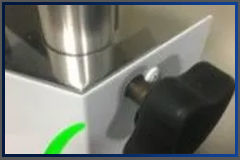NOTE 1: The die orifice is very sensitive, and it can be damaged easily. Even minor contamination on top/inside the die or minor damage on the surface/edge can cause dramatic changes in your results.
NOTE 2: Spreading very little anti-seize on the body of die holder can prevent sticking it inside the barrel during the test.
Barrel Charging Procedure Before Running the Test in LCR7001
Azadeh Farahanchi, Rheological Scientist, Ph.D
03.04.2020
1).Inspect the rheometer including barrel, piston, and die. Clean each of them if necessary.
2). Insert the die in die holder and fastener.
- NOTE 1: The die orifice is very sensitive, and it can be damaged easily. Even minor contamination on top/inside the die or minor damage on the surface/edge can cause dramatic changes in your results.
- NOTE 2: Spreading very little anti-seize on the body of die holder can prevent sticking it inside the barrel during the test.
3). Open the barrel and fasten the die at the bottom of the barrel (by rotating the die fastener un-clockwise until it is tight enough).
- NOTE 1: If the die is not tightly fastened, it might move during the test. This causes leaking of the plastic melt from barrel during the test.
4). After reaching to the set temperature press RCAL on the software.
- NOTE 1: This step re-zero the rheometer sensors (load cell and/or pressure transducer) to a zero value.
- NOTE 2: Make sure the rheometer (barrel and die) are reached to thermal equilibrium before pressing the RCAL button.
5). Charge the barrel with about 1/3 of your sample. Manually tamp/pack the charge several times using the packing tool. Continue this step until the barrel is filled to within approximately 12.5 mm of the top.
- NOTE 1: Proper packing with normal hand force is necessary in order to expel any entrapped air pockets or volatiles
6).Close the barrel ALL THE WAY and rotate the locking knob clockwise.
- NOTE 1: If the barrel is not closed all the way, the piston will not be in alignment with the barrel and the force from load cell can bend the piston.
7).Place the piston in the barrel and close the safety shield
8).Manually move the crossbar down by pressing the DOWN button on the software or rheometer until it completely covers the top section of the piston.
9).Open the safety shield and insert the piston clip.
10). Close the safety shield and run the test.









.jpg)
.jpg)
.jpg)
.JPG)
.JPG)
.jpg)
.jpg)